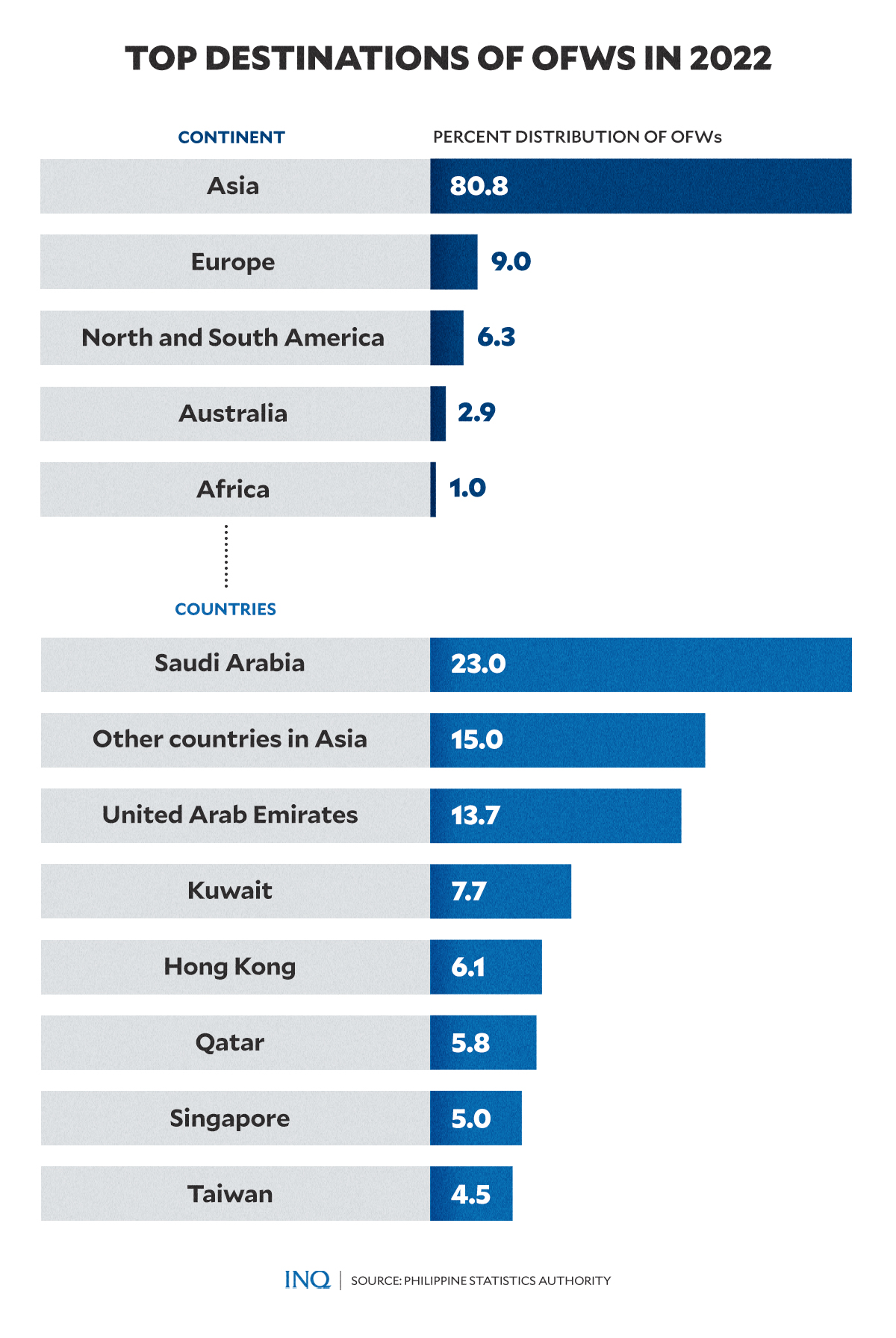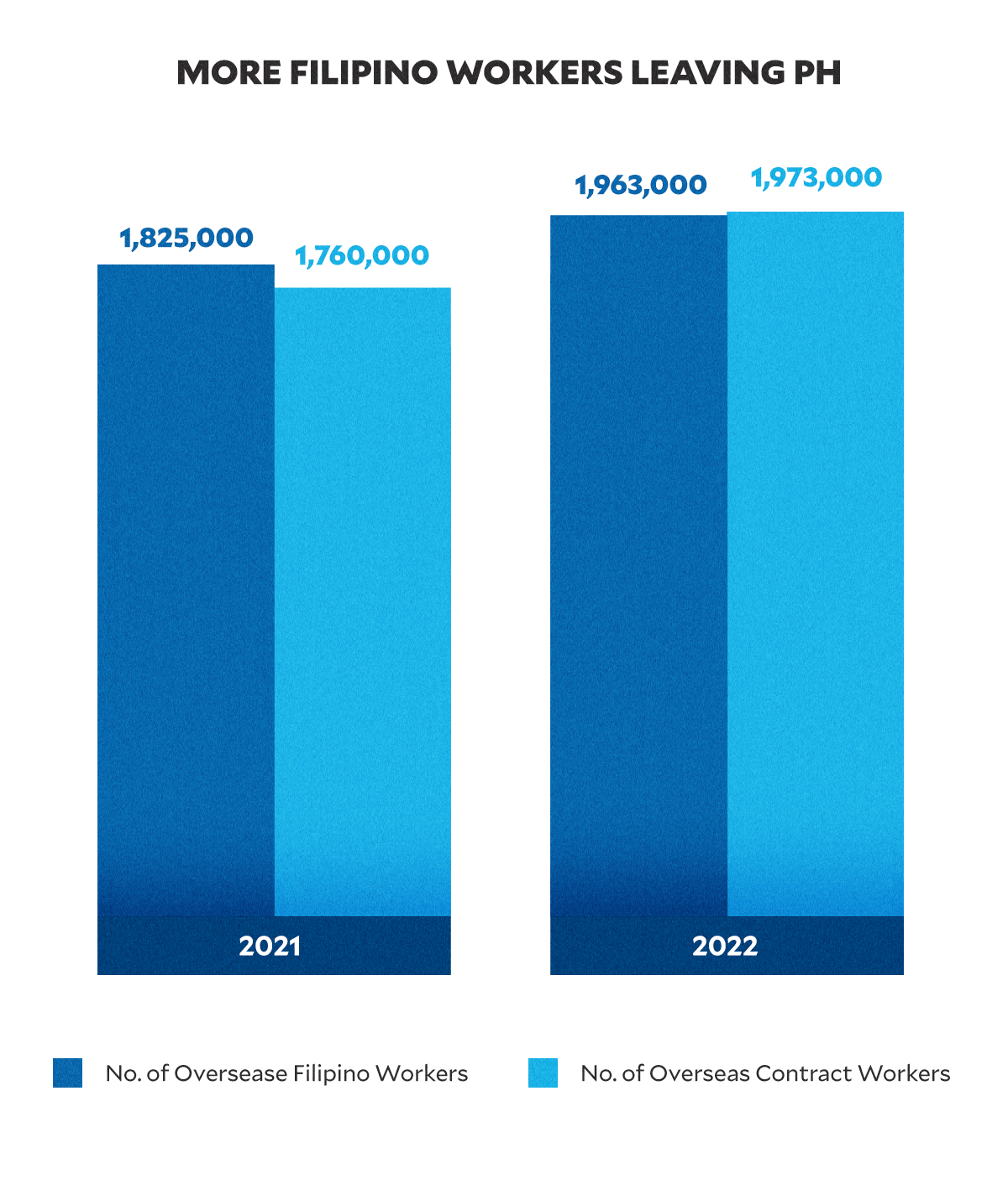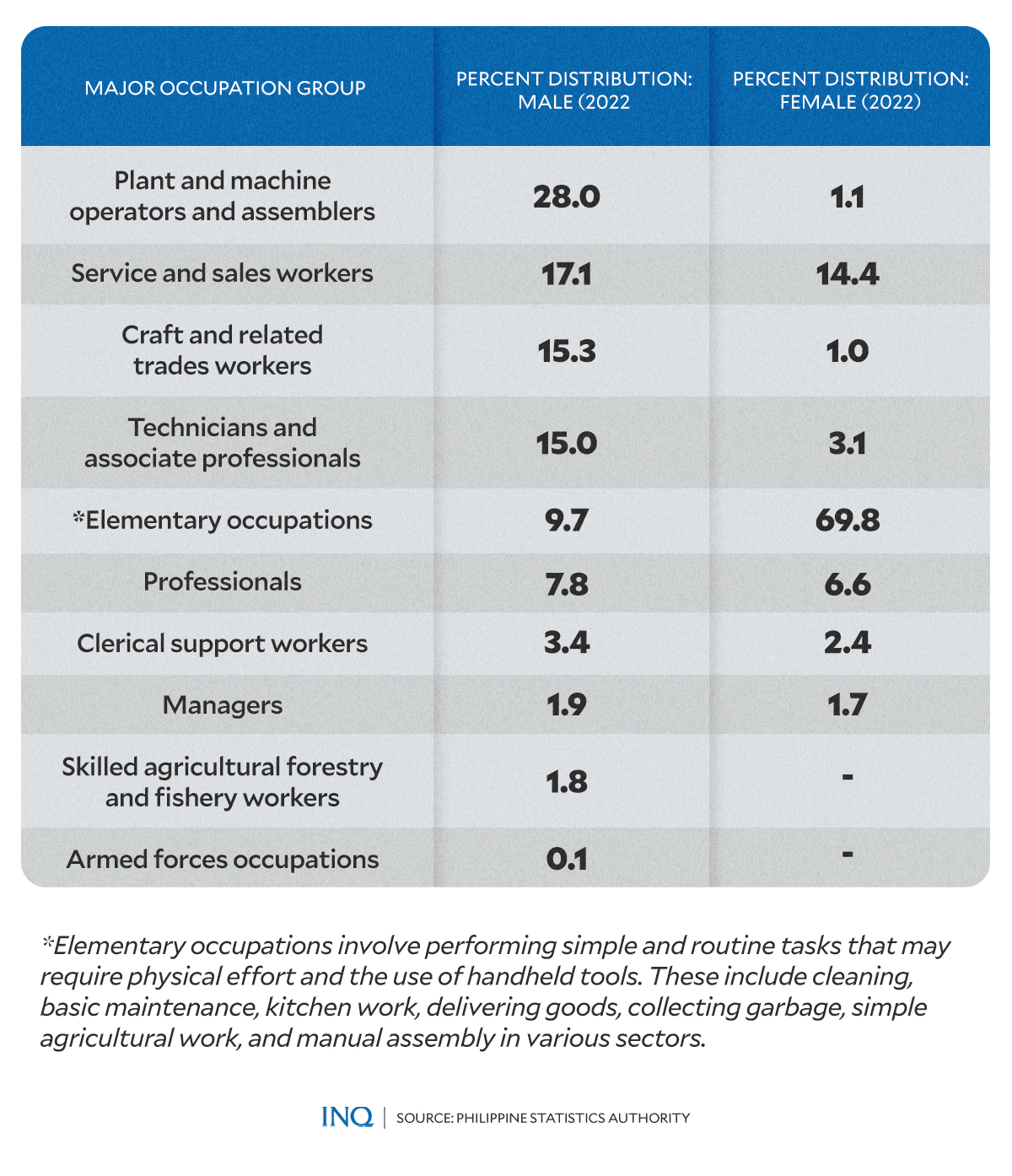Highly-educated Filipinos as OFWs: A double-edged sword for PH
MANILA, Philippines — In a world that’s constantly on the move, the Philippines has carved out a unique position as a powerhouse in the export of skilled labor. Every year, waves of Filipinos pack their bags to set out across the globe, driven by the pursuit of brighter futures and better opportunities.
This mass migration, while opening doors for many, wields a double-edged sword: it propels Filipino talent onto the world stage, filling crucial roles in international industries, yet it simultaneously strains the local workforce, especially in critical sectors such as health care and education.
These workers, known as Overseas Filipino Workers (OFWs), are not just employees abroad; they are the lifeline of their homeland. Their remittances are the financial bedrock for countless families and a vital cog in the machinery of the Philippine economy.
However, this exodus of talent also brings to light the concerning issue of ‘brain drain,’ leaving the nation in a perpetual struggle to replenish its pool of professionals.
This phenomenon is reshaping the Filipino identity on the global map, striking a balance between loss and gain, between the home left behind and the promise of the world beyond.
Article continues after this advertisementHighly educated workers leave PH
Despite its relatively small population of just over 100 million, the Philippines has made a significant impact on the world’s skilled workforce. With an impressive 1.89 million highly educated Filipinos residing in OECD countries, the country ranks third in the world for having the largest educated diaspora, falling behind only India with 3.12 million and China with 2.25 million.
Article continues after this advertisementThe significance of the country’s contribution to the global pool of skilled workers becomes even more pronounced when considering the country’s much smaller population compared to India and China, both of which have populations exceeding a billion. India’s population stands at approximately 1.325 billion, while China’s is around 1.379 billion.
However, this success story is not without its challenges. The country faces a critical issue: a high percentage of its highly educated workforce is emigrating abroad.
In recent years, the number of Overseas Filipino Workers (OFWs) has continued to grow, with data from the Philippine Statistics Authority showing a steady increase from 1,825,000 in 2021 to 1,963,000 in 2022. These numbers represent a significant proportion of the country’s workforce, engaging in a diverse array of occupations across the globe.
Of the Filipinos returning from overseas, data from the International Organization for Migration (IOM) revealed that 49.6 percent have some college education or higher, reflecting the level of education many choose to take abroad.
This phenomenon is more pronounced in the Philippines compared to countries like India, where the emigration rate of educated individuals is minimal despite its vast population. This raises concerns about the sustainability of the country’s workforce development.
It is essential to note that while other countries like the United Kingdom (1.75 million), Germany (1.47 million), Poland (1.20 million), Mexico (1.14 million), and Russia (1.06 million) also supply skilled migrants, the situation in the Philippines is particularly striking.
The country’s departure of a significant portion of its skilled and educated workforce highlights its crucial role in the global marketplace. It also underscores the potential challenges to its workforce development and sustainability.
Where OFWs go
According to data from the Philippine Statistics Authority (PSA) for 2022, Asia remains the predominant destination for OFWs, accounting for 80.8 percent of the Filipino workforce abroad. This substantial proportion reflects the longstanding ties and geographic proximity that facilitate labor migration within the region.
The Middle East is another crucial employment hub, with Saudi Arabia hosting 23.0 percent of OFWs alone. The United Arab Emirates and Kuwait also significantly contribute, with 13.7 percent and 7.7 percent respectively.
These regions depend on the diverse skill set of OFWs, particularly in sectors such as health care, construction, and domestic services, where their hard work and adaptability are highly valued.
In addition to Asia and the Middle East, other parts of the world also draw Filipino talent. Europe accounts for 9.0 percent of OFWs, while North and South America collectively make up 6.3 percent, with countries like the United States and Canada becoming increasingly popular due to higher wages, better living conditions, and opportunities for family reunification.
These nations, known for their multicultural makeup, provide a supportive environment for Filipinos, helping to foster a sense of community and belonging far from home.
This significant presence of OFWs across various regions highlights their integral role in the global workforce. It sets the stage for a deeper exploration into the impact of their financial contributions, mainly through remittances, on both their host countries and the Philippines.
Rising remittances
In 2023, remittances from OFWs continued to play a pivotal role in the Philippine economy, highlighting the significant financial contributions of Filipinos working abroad.
According to data from the Bangko Sentral ng Pilipinas (BSP), remittances reached an all-time high, with cash remittances alone amounting to $33.491 billion for the year. This marked a growth of 2.9 percent over the previous year, underscoring the resilience of OFWs’ financial contributions despite global economic uncertainties.
December 2023 saw a notable increase in remittances, with a 3.8 percent rise to $3.28 billion compared to the same period in 2022, reflecting the seasonal trend of increased remittance flows during the holiday season.
This boost was largely attributed to the contributions from both land-based and sea-based workers, demonstrating the ongoing commitment of OFWs to support their families back home during significant times of the year.
The United States, Singapore, Saudi Arabia, and Japan were among the leading sources of these remittances, pointing to the diverse global footprint of the Filipino workforce. The steady flow of funds from these countries not only supports individual families but also plays a crucial role in stabilizing the Philippine peso and bolstering the country’s economic growth.
Projected trends suggest that remittances will continue to grow, with an expected increase of 3 percent in the forthcoming years. The data showed that OFWs continue to send financial support back home, ensuring a robust economic connection with their homeland.
This steady stream of funds not only aids individual family members but also plays a crucial role in maintaining the economic stability of the Philippines.
Addressing ‘brain drain’
As the Philippine government acknowledges the profound impact of brain drain on national development, President Ferdinand Marcos Jr. has proposed a new strategy aimed at retaining local talent.
The strategy involves enticing graduates, particularly from the health and information technology sectors, to serve in the Philippines before moving abroad.
READ: Marcos wants ‘strategy’ for graduates to work in PH before going abroad
“We have to come up with some kind of strategy wherein, let’s say, you provide scholarships, and then the scholarship agreement includes that you stay three years. After that, then they’re free to go,” Marcos said
This initiative is complemented by the acknowledgment that while Filipino graduates are free to seek opportunities abroad, the loss of trained professionals could be mitigated by such programs.
According to Marcos, these efforts need to be supported by more attractive local employment options that could compete with international offers.
READ: Marcos wants ‘strategy’ for graduates to work in PH before going abroad
In support of this strategy, the Private Sector Advisory Council’s Jobs Sector Group (PSAC-Jobs) has highlighted that the local market struggles to match the high salaries offered in countries like the United States, the United Kingdom, Australia, and Europe.
“I think what we can do is to continue to offer certificate programs and train their skills. I think we can do that. There’s no way for us to retain them,” said Teresita Sy-Coson of SM Investments Corp.
The PSAC has also urged a more coordinated approach among government agencies—including the Department of Health (DOH), the Commission on Higher Education (CHEd), and the Department of Migrant Workers (DMW)—to create more compelling opportunities for Filipino workers.



















